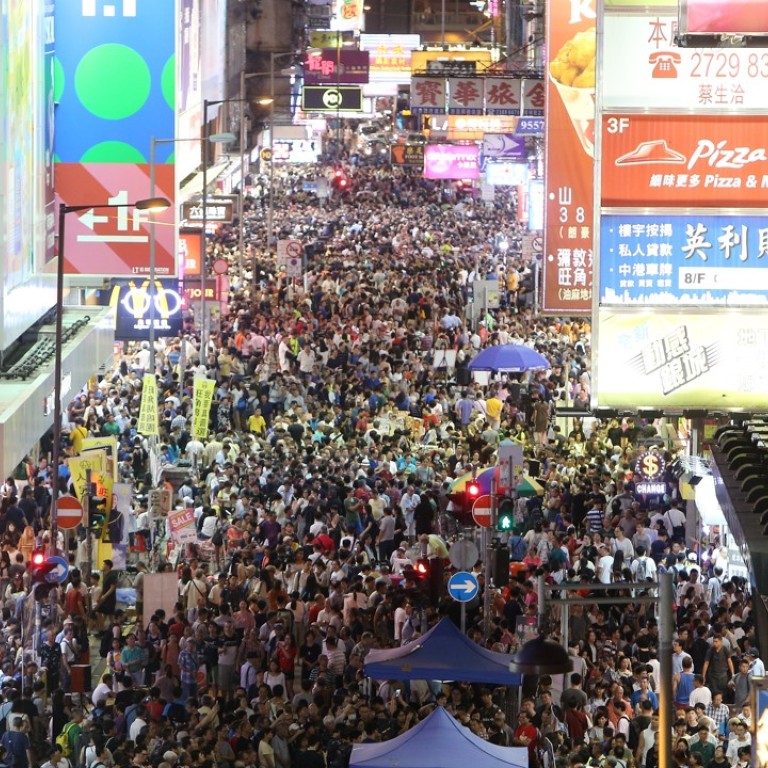
Hongkongers watch Mong Kok street artists’ deafening, tearful farewell before iconic pedestrian zone closure
As planned, at 10pm police broadcast messages asking entertainers and audience members to leave colourful area
Throngs of Hongkongers, tourists and buskers flocked to Mong Kok’s famous pedestrian zone on Sunday night for one last hurrah before it was to be closed for good while police officers fanned out in large numbers to ensure the night would not turn ugly.
The singing and farewell speeches were more deafening than ever, as performers tried their best to outdo one another to entertain their fans a final time at the iconic area – along a 500-metre stretch of Sai Yeung Choi Street South – that had captured the imagination of tourists and local residents alike for nearly two decades.
Street artists wrapped up their performances with “farewell” karaoke songs, weaving in forlorn farewell messages as well as tearful embraces.
Elderly couples and their friends re-enacted their younger years with cha-cha style dancing on the street, as others scrambled to take selfies with the zone’s best-known personalities.
But when the clock struck 10pm, there were to be no encores for street performers who were forced to give up the space to vehicular traffic again.
Indeed, shortly after 10pm, police officers and personnel from the Food and Environmental Hygiene Department started urging performers and pedestrians to return to the pavements and give way to motorists. Most cooperated.
Mong Kok buskers say thank you and good night
At about 10.40pm, the clearance was completed and cars were able to pass through Sai Yeung Choi Street South.
The pedestrian zone in downtown Mong Kok was to open to vehicular traffic around the clock from 10pm Sunday.

“I think it’s quite disappointing this had to happen,” local resident Benson Chung said, attending with his girlfriend Mandy. “It is a tragedy of sorts.”
The couple decided to return on Sunday to the place they had spent their first date three years prior, listening to street performances.
I think it’s quite disappointing this had to happen. It is a tragedy of sorts
Singer Steven Lai Cheuk-yin said he had come to “witness the final chapter of this street”.
“It’s a bit sad to see it have to end this way,” Lai added. “Everyone could have just turned the volume down a notch.”
Ng Chi-fai, a spokesman for a group of 20 street performers who call themselves the Mong Kok Street Culture Society, said closing the pedestrian zone was “not addressing the issue”.
“It will only force the artists to other places to perform.”
Ng said some entertainers had planned to move to the Tsim Sha Tsui waterfront, another site popular with tourists.
He accused the government and district councillors of failing to acknowledge the street performers’ contribution to the local scene, saying their presence in Hong Kong “created a vibrant street culture”.

Harbourfront Commission chairman Vincent Ng Wing-shun said his commission could look into imposing regulations should the influx of street performers at the harbourfront cause a nuisance.

“Extremely right can become extremely wrong,” Ng said on a televised interview on Sunday. “When one thing goes to the extreme, the whole thing can’t work any more.”
“It is the ideal that we can accommodate all kinds of performances,” he explained. “But we need to take into consideration the situation of Hong Kong. We all welcome street performances. But Hong Kong is densely populated. There is perhaps the need for a certain level of management, like, which kind of activities are allowed in which places.”
One of the options to consider, Ng said, was a licensing system.

The zone had attracted thousands of tourists a day and was designated car-free from 4pm to 10pm on Saturdays, and from 12pm to 10pm on Sundays and public holidays. The hours were shortened several times between 2010 and 2014 following complaints about noise and overcrowdedness.
In 2000, the area was designated a pedestrian zone to improve the pedestrian environment. But it subsequently attracted buskers, hawkers, and other singers and dancers to stage shows. Makeshift booths occupied by competing internet companies lined the thoroughfare, their salesmen clustering up and down the street.
More sightseers as well as bargain hunters were thus drawn to the area. Occasionally, political parties would capitalise on the crowds by staging forums or protests there.

Competition for space coupled with performers’ desire for attention inevitably led to overflowing crowds and volume levels being raised. And the higher the levels, the more forceful the complaints.

The Yau Tsim Mong district council in May passed a motion to terminate the zone. That in effect meant the street would not be closed any longer to cars and that street performers would not be able to return for their shows after Sunday.
Yau Tsim Mong district councillor Andy Yu Tak-po, of the Civic Party, urged officials to step up patrols so that salesmen would not merely relocate their booths on the pavements.
Mong Kok buskers plan next move ahead of closure of Hong Kong pedestrian zone
“I hope the Food and Environmental Hygiene Department will continue keeping an eye on the situation after the pedestrian zone’s closure,” Yu said.
A spokesman for the department said in a statement: “Commercial activities in public places and obstruction thus caused, being a street management issue, falls within the purview of a number of government departments.
Buskers lower decibel levels as mock regulations on noise given an unofficial trial
“The core function of [our department] is to upkeep environmental hygiene. Hence, [we accord] priority to handling cases involving obstruction to scavenging operations or illegal hawking, and take enforcement action in the light of the circumstances on the ground.”
Business and Professionals Alliance lawmaker Dr Priscilla Leung Mei-fun, of Kowloon West constituency, welcomed the zone’s closure, saying residents had been suffering from noise nuisances because of a lack of effective regulation.
Additional reporting by Danny Mok


